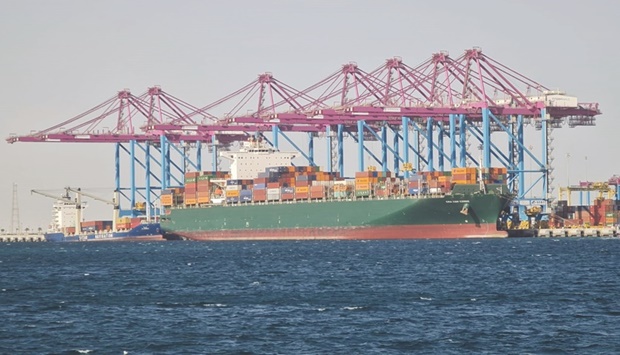*Hamad Port's container capacity rises to 3mn TEUs per year
QTerminals has started full-scale operations of the first and second phases of Hamad Port’s second container terminal (CT2), thus enhancing the port’s total capacity to 3mn TEUs (twenty-foot equivalent) per year.
The development of CT2 was completed within budget and the timetable set out, despite the difficulties posed by the coronavirus (Covid-19) pandemic.
The CT2 -- equipped with the latest environmentally friendly, technologically advanced equipment to keep pace with the needs and requirements of the global shipping lines -- is focused towards increasing the volume of the intra-regional trade of Qatar and with countries world-wide, as well as improving the country’s competitiveness by turning it into regional business hub.
QTerminals, which manages and operates CT1 and CT2 of Hamad Port has so far completed more than 6mn man-hours without a lost time incident during operations and the development works of CT2.
The CT2 development project consists of four phases. The area of Phases 1 and 2 of Hamad Port’s CT2 is 380,000 sqm and the quayside is 624m long. Phases 3 and 4 would be developed later to raise the port’s operational capacity according to local market needs.
The equipment deployed in phases 1 and 2 of CT2 include seven super post-Panamax STS (ship-to-shore) quay cranes with advanced technology, including semi-automation and remote-control operations.
STS cranes are known for being extremely fast and highly efficient in handling containers and capable of handling the latest class of vessels. Each crane can handle four 20’ containers or two 40’ containers at the same time.
The CT2 is equipped with 26 RTGs (rubber tyre gantry cranes) which can stack the containers six tiers high. CT2’s RTGs are battery hybrid and are used to handle containers on the landside. This technology reduces the environmental impact of RTG operations by reducing fuel consumption and emissions.
The CT2 has 22 fully electric terminal tractors (APM 75T HE) for container transportation within the terminal and the port. This type of terminal tractor is capable of functioning very efficiently in high temperatures and is equipped with advanced batteries, entirely solid-state technology, insensitive to temperature variations from -20 to +160°C.
They are also eco-friendly and save energy. Being fully electric makes them clean and sustainable with no pollution, carbon emissions or noise.
They have low operational costs as each tractor will save nearly QR45,000 per year compared to diesel powered tractors - one kilowatt per hour costs are QR0.32 in electric tractors and QR2.32 per litre in diesel powered ones.
During the development of CT2, Qatar National Vision 2030 has been followed, which supports increasing the national manufacturing capacity and to deploy the latest technologies that are based on environmental sustainability and clean energy. Over 70% of the materials used in the development of the infrastructure of CT2 were 'Made in Qatar’ to the very latest specifications.
The CT2’s service buildings and infrastructure have been completed, including the diesel generator house, main intake substation, reefer stack gantries, quayside amenities, 5G network, ELV and SSD systems and storm water networks.
The terminal gates for both CT1 and CT2 are automatic with seamless connections to the operations systems and electronic data exchange.
(Ends)


